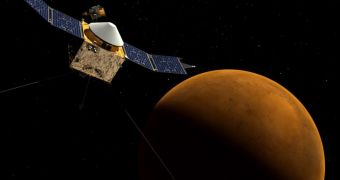The past decade has revealed that Mars was not always the inhospitable world it is today. NASA plans to use the Mars Science Laboratory (MSL) and the Mars Atmosphere and Volatile EvolutioN (MAVEN) missions to figure out exactly what happened, and whether that can be reversed.
At this point, what was once a strong atmosphere is just a wispy layer of chemicals, which do nearly nothing to protect the Martian surface from the effects of radiations coming in from the Sun and space.
At the same time, dangerous chemicals such as hydrogen peroxide permeate soils at most locations, making it extremely difficult for anything to live there. Liquid water no longer exists – as far as we know – as the liquid has either been removed from the planet, or is trapped in underground ice sheets.
But data from a large number of missions – such as the NASA MER, MRO, Odyssey, Phoenix and the European Space Agency's (ESA) Mars Express – have provided tantalizing evidence of a past when the Red Planet was a warm world, featuring lakes, rivers, deltas and even an ocean of water on the surface.
MSAL and MAVEN are bound to analyze the signs these features left behind, although in different ways. The MSL rover Curiosity will land in Gale Crater, a huge hole in the ground featuring a 3-mile (5-kilometer) mountain at its center.
On the other hand, the MAVEN spacecraft will analyze the Martian atmosphere from planetary orbit. Yet, their studies are meant to be complementary to some extent, as both are focused on past climate.
“The ultimate driver for these missions is the question, did Mars ever have life? Did microbial life ever originate on Mars, and what happened to it as the planet changed?” asks NASA Goddard Space Flight Center (GSFC) expert Paul Mahaffy.
“Did it just go extinct, or did it go underground, where it would be protected from space radiation and temperatures might be warm enough for liquid water?” the expert goes on to say.
On Curiosity, the GSFC team contributed the Sample Analysis at Mars (SAM) instrument suite, which is meant to search for signs of water, carbon, and other chemical elements that are suited for the development of life inside Martian soil samples.
“Both MAVEN and Curiosity/SAM will determine the history of the Martian climate and atmosphere using multiple approaches,” explains University of Colorado (UCB) Laboratory for Atmospheric and Space Physics (LASP) expert Bruce Jakosky.
“Measurements of isotope ratios are an approach shared by both missions,” concludes the expert, who is the principal investigator for the MAVEN mission.

 14 DAY TRIAL //
14 DAY TRIAL //